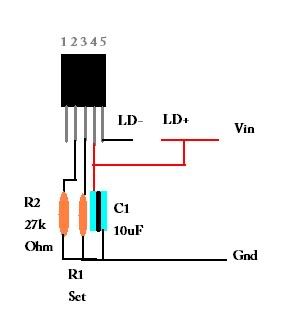- Joined
- Jan 14, 2011
- Messages
- 3,816
- Points
- 63
I found this great IC.
I am able to drive an LOC to 1.25-1.3A from it via a single Li-ion (14500) (of course, on a test load, not an ACTUAL LOC). I did the same test with a different set-up and got roughly half of that.
It's a great configuration, really, it is. The IC itself is capable of handling up to 3A, and it's an ULDO regulator.
I have been struggling with this IC for some time now, trying to use the current source mode on it, but it doesn't seem to want to work. However, I now have a working, stable driver using the "LDO LED driver" sample set-up from the Typical Applications part in the Datasheet.
Anyway, here is the circuit in simple terms:

The pins are as follows:
1 - NC
2 - Set
3 - Out
4 - Vcontrol
5 - In
So I actually have no idea how this works, to be honest. But, it works. I have yet to figure out the drop-out voltage yet either, but supposedly, it's only 310mV... it's either that, or 1.25V, anyway. But if it's 1.25V, how am I managing to power an LOC off of it with only a single 14500 at such high load currents?
Anyway, the basic equation for getting the current for your diode is easy:
A = 1.25V/Rset
Not exactly sure what the 27k Ohm resistor does, but it has to be there.
Anyway, what do ya'll think? I think it could be very effective because it's easy to use and there is a possibility of an extraordinarily low drop-out.... Could this be the new DDL drive?
EDIT: I believe the LDO is confirmed. I am capable of running the 4 1N4001 diodes with 3.98Vin from my battery.
Oh, and I know this works for higher voltage situations, too, because I tried it with 6 1N4001 diodes as well, but with a higher Vin.
EDIT 2: While it did start to drop to ~500mA from one 14500 battery with this circuit (when it should have been set at 1.25A), I believe that is due to the resistors dropout from the testload, because I tested the output and it is giving off a steady 3V or so with just one 14500 li-ion. Neat!
I am able to drive an LOC to 1.25-1.3A from it via a single Li-ion (14500) (of course, on a test load, not an ACTUAL LOC). I did the same test with a different set-up and got roughly half of that.
It's a great configuration, really, it is. The IC itself is capable of handling up to 3A, and it's an ULDO regulator.
I have been struggling with this IC for some time now, trying to use the current source mode on it, but it doesn't seem to want to work. However, I now have a working, stable driver using the "LDO LED driver" sample set-up from the Typical Applications part in the Datasheet.
Anyway, here is the circuit in simple terms:

The pins are as follows:
1 - NC
2 - Set
3 - Out
4 - Vcontrol
5 - In
So I actually have no idea how this works, to be honest. But, it works. I have yet to figure out the drop-out voltage yet either, but supposedly, it's only 310mV... it's either that, or 1.25V, anyway. But if it's 1.25V, how am I managing to power an LOC off of it with only a single 14500 at such high load currents?
Anyway, the basic equation for getting the current for your diode is easy:
A = 1.25V/Rset
Not exactly sure what the 27k Ohm resistor does, but it has to be there.
Anyway, what do ya'll think? I think it could be very effective because it's easy to use and there is a possibility of an extraordinarily low drop-out.... Could this be the new DDL drive?
EDIT: I believe the LDO is confirmed. I am capable of running the 4 1N4001 diodes with 3.98Vin from my battery.
Oh, and I know this works for higher voltage situations, too, because I tried it with 6 1N4001 diodes as well, but with a higher Vin.
EDIT 2: While it did start to drop to ~500mA from one 14500 battery with this circuit (when it should have been set at 1.25A), I believe that is due to the resistors dropout from the testload, because I tested the output and it is giving off a steady 3V or so with just one 14500 li-ion. Neat!
Last edited:





